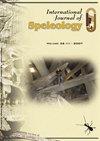在分层大陆喀斯特含水层中独立冷矿和热矿双泉的水动力模型,Camou, Arbailles地块,pyrsamnade,法国
IF 1.3
4区 地球科学
Q3 GEOSCIENCES, MULTIDISCIPLINARY
引用次数: 1
摘要
Camou泉(法国西比利牛斯山脉的Arbailles Massif)显示出一种不同寻常的紧密结合,即一种典型的冷岩溶泉和一种热矿泉(33.5°C;盐度17.7g/L),前者排干了阿尔拜尔山脉的Urgonian西翼。后者主要通过Apanicé向斜的深环在三叠纪蒸发岩的接触处获得矿化。这种深水的快速上行发生在大型活动线的交叉处(位于深处的北比利牛斯逆冲断层和Saison横向断层)。附近Maddalen洞穴的洞穴潜水使其能够到达冷泉起源处的潜水通道,但冷泉也穿过第三个集水坑中的热体(S3)。两个水体都被一条尖锐的温跃线隔开。6个压力-温度数据记录器沿温跃层放置在两个水体中6个月。位于温跃层两侧下游的数据记录器显示,在洪水开始时,首先是热体上升,然后是受岩溶含水层水头压力变化控制的冷洪水对整个潜水通道的入侵。根据对这些机制的观察,我们推导出了一个流体动力学模型,其中温暖的羽流上升到寒冷的含水层中,没有显著的混合。水体的这种独立性可以通过界面处湍流速率的降低来解释,这是由于密度梯度的急剧增加。相对不混合实际上并不需要独立的“水密”路线,因此,即使在同一管道中,两个水体也可以共存。该模型局部暗示了靠近泉水的未知二次通道的存在,这允许在枯水期将每个水体独立排放到单独的出水口。这种与密度差异有关的层状含水层在沿海岩溶(佛罗里达州、法国卡兰克…)和大陆蒸发岩岩溶(德国哈茨河的Schlotten、乌拉尔的Kungur岩溶…)中很常见,但在大陆碳酸盐岩岩溶区仍然很难识别,主要是因为难以进入。与法国阿尔卑斯海岸的梅斯克拉泉一起,在同一门廊排放的卡穆双泉就是一个突出的例子,可以直接研究高度对比的水体的分层和动态。本文章由计算机程序翻译,如有差异,请以英文原文为准。
Hydrodynamic model for independent cold and thermo-mineral twin springs in a stratified continental karst aquifer, Camou, Arbailles Massif, Pyrénées, France
The Camou springs (Arbailles Massif, French Western Pyrenees) display an unusual close association of a typically cold karstic spring that drains the Urgonian western limb of the Arbailles, and a thermo-mineral spring (33.5°C; salinity 17.7 g/L). The latter gains its mineralization at the contact of Triassic evaporites mainly through a deep loop in the Apanicé syncline. The fast upflow of this deep water occurs at the cross of large active lines (the North-Pyrenean thrust located at depth, and the Saison transverse fault). Cave diving in the nearby Maddalen Cave allowed reaching the phreatic passage at the origin of the cold spring, which however also crosses the thermal body in the third sump (S3). Both water bodies are separated by a sharp thermocline. 6 pressure-temperature dataloggers were placed in both water bodies along the thermocline for 6 months. The dataloggers located downstream on either side of the thermocline show at the beginning of flood first a rise of the thermal body, then an invasion of the whole phreatic passage by the cold floodwater, controlled by head pressure changes in the karst aquifer. From observation of these mechanisms, we deduce a hydrodynamic model with a warm plume rising into the cold aquifer, without significant mixing. Such independence of water bodies is explained by the decrease of turbulent rate at the interface, due to the sharp density gradient. The relative absence of mixing does not actually require independent “watertight” routes, both water bodies can thus coexist even in the same conduit. This model locally implies the existence of unknown secondary passages close to the spring, which allow an independent draining of each water body toward separate outlets during low stage. Such type of stratified aquifer linked to density differences is common in coastal karst (Florida, French Calanques…), in the continental evaporite karst (Schlotten of the Harz in Germany, Kungur karst in Ural…), but remains poorly identified in continental carbonate karst areas, mainly because of the difficulty of access. Together with the Mescla spring in French Alpes-Maritimes, the Camou twin springs discharging in the same porch are an outstanding example, allowing a direct study of the stratification and the dynamic of highly contrasted water bodies.
求助全文
通过发布文献求助,成功后即可免费获取论文全文。
去求助
来源期刊

International Journal of Speleology
地学-地球科学综合
CiteScore
3.10
自引率
23.10%
发文量
12
审稿时长
>12 weeks
期刊介绍:
The International Journal of Speleology has the aim to get cave and karst science known to an increasing number of scientists and scholars. The journal therefore offers the opportunity to all scientists working in and on karst to publish their original research articles or their review papers in an open access, high quality peer reviewed scientific journal at no cost. The journal offers the authors online first, open access, a free PDF of their article, and a wide range of abstracting and indexing services.
 求助内容:
求助内容: 应助结果提醒方式:
应助结果提醒方式:


